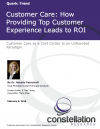Incorrect Assumptions Lead Executives to Believe Customer Service Is a Cost Center
There are a number of ways in which poor customer care can cost the organization. Unfortunately, executives who believe customer service is a cost center fail to understand the increase in expenses that arises from poorly implemented and costly customer service solutions. Some of the implications of poorly implemented customer care are:
There are a number of ways in which poor customer care can cost the organization. Unfortunately, executives who believe customer service is a cost center fail to understand the increase in expenses that arises from poorly implemented and costly customer service solutions. Some of the implications of poorly implemented customer care are:
- Deficiencies in achieving First Contact Resolution (FCR)
- Increases in Average Handle Time (AHT) for phone, email, chat and social media
- Inefficiencies in self-service, call deflection, agent-assisted related support costs and knowledge base capabilities
- Requirements to add staff to handle more customer calls or call spikes
- Insufficiencies in shopping cart or in-game customer service capabilities
- Failures in using customer feedback to improve processes or products.
Agile Customer Care Delivers High Return on Investment
If companies deploy customer care systems that are agile, then will receive many benefits. These include:
Recommendations and the Bottom Line: Agile Customer Care Delivers ROI
Companies looking to reduce their customer service costs should look to agile customer care solutions. Savings can be found from increasing FCR and self-service as well as decreasing average handle time. In addition, if the solution is used proactively by the organization, it can help with process improvements, product improvements and even lead to revenue generation. Companies contemplating an agile customer care solution should consider the following three steps: Review current costs of running the contact and customer care center. Look at critical metrics like FCR, AHT, as well as the opportunity to generate revenue, improve marketing and enhance employee engagement.
Companies looking to reduce their customer service costs should look to agile customer care solutions. Savings can be found from increasing FCR and self-service as well as decreasing average handle time. In addition, if the solution is used proactively by the organization, it can help with process improvements, product improvements and even lead to revenue generation. Companies contemplating an agile customer care solution should consider the following three steps: Review current costs of running the contact and customer care center. Look at critical metrics like FCR, AHT, as well as the opportunity to generate revenue, improve marketing and enhance employee engagement.
Compare current costs of a traditional customer care solution with the costs and benefits of an agile customer care solution. You want to write a requirements definition document that will specify what your use cases are, explain what pain points you want the software to solve and then write an RFI (request for information) and or follow up with an RFP (request for proposal).
Build a business case and a return on the investment model to show the value of switching to an agile customer care solution. As you interview vendors, make sure that they answer all your questions and you understand how the software will solve your business issues.
Build a business case and a return on the investment model to show the value of switching to an agile customer care solution. As you interview vendors, make sure that they answer all your questions and you understand how the software will solve your business issues.
It’s time the paradigm that customer care is a cost-center be done with. It’s only a cost center if the software is difficult to use, poorly implemented, isn’t agile, requires a lot of training… If you are not getting the benefits and turning your contact center into a profit center, you’ll want to download the rest of the report here.

@DrNatalie, VP and Principal Analyst, Constellation Research
Covering Customer-Facing Applications that Deliver Awesome Customer Experiences



